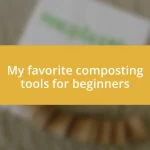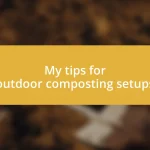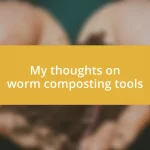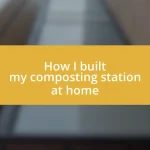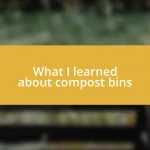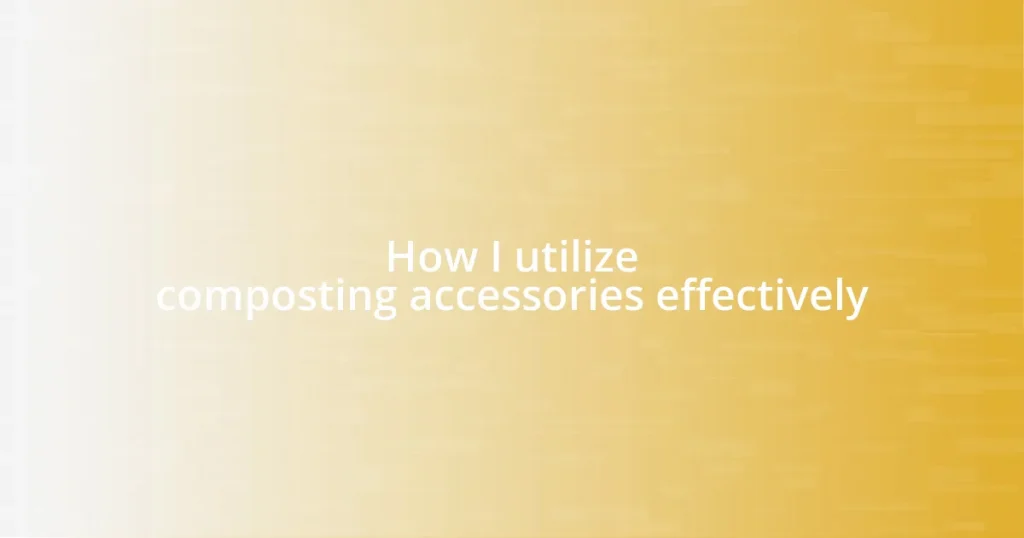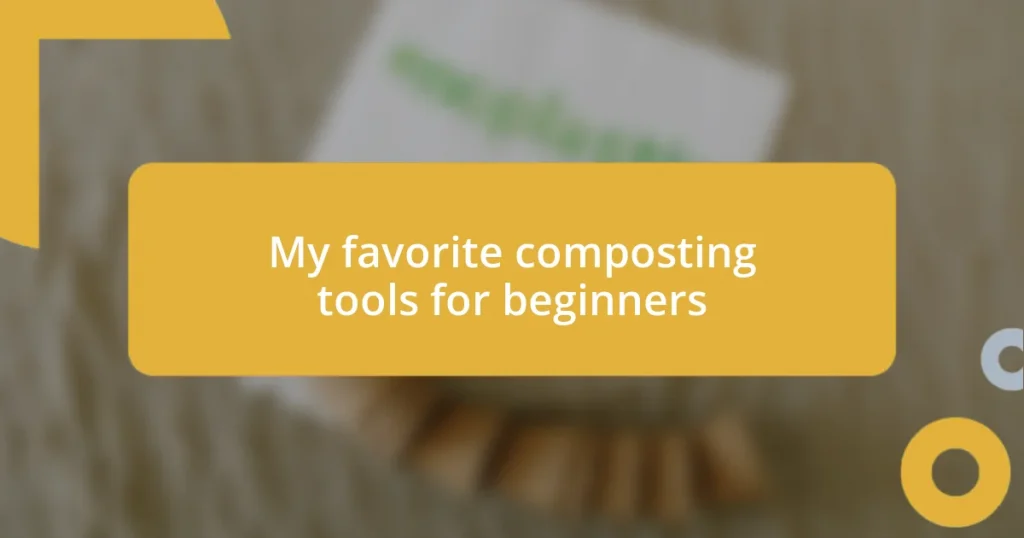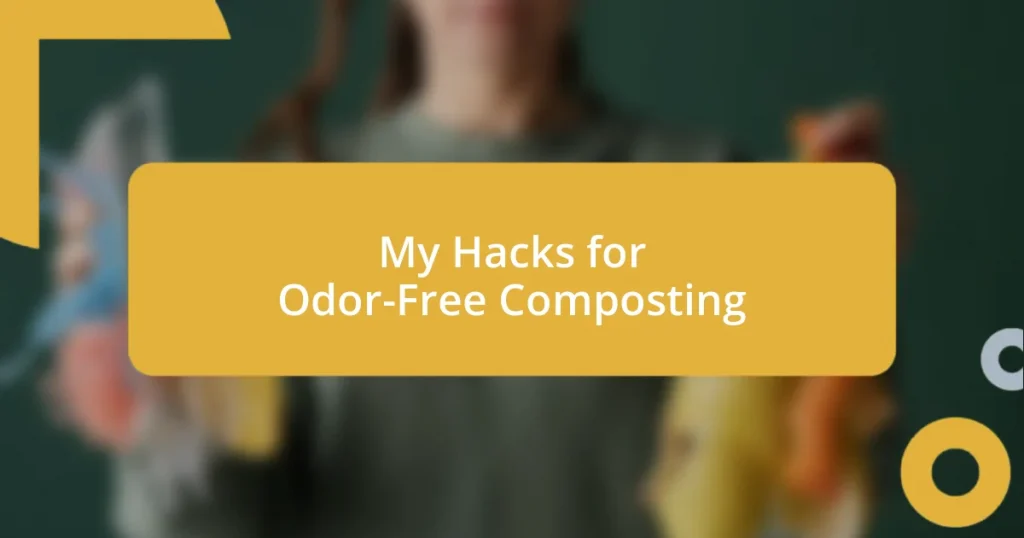Key takeaways:
- Utilizing composting accessories like aerators, thermometers, and sifters significantly enhances the efficiency and satisfaction of the composting process.
- Choosing the right compost bin, whether closed or open, impacts airflow, odor control, and overall decomposition speed, tailored to your composting goals.
- Regular maintenance of composting tools, such as cleaning and inspecting for wear, prolongs their lifespan and ensures optimal performance.
- Maximizing compost production requires a balanced carbon-to-nitrogen ratio, consistent turning of the pile, and monitoring moisture levels for effective decomposition.

Understanding composting accessories
Composting accessories can truly enhance the efficiency of your composting efforts. From aerators to compost bins, each tool plays a unique role in creating the perfect environment for decomposition. I remember the first time I used a compost thermometer; it was a game-changer. Suddenly, I was able to monitor the internal temperature and ensure that my compost was actively breaking down, which made the whole process feel more engaging and successful.
One of my favorite composting accessories is the compost sifter. When I first sifted my finished compost, the feeling of accomplishment was incredible. It was like finding treasure in your own backyard! Seeing the rich, dark soil was a gratifying reward for my patience. How many of us take time to appreciate those small victories in our gardening journey? By investing in specific tools that facilitate compost management, we not only boost our gardening effectiveness, but we also nurture a deeper connection to the earth.
Another essential accessory I’ve come to rely on is the kitchen compost bin. It has a special place on my countertop, and it reminds me to be proactive about my food scraps. I often think of it as a small commitment to sustainability—a daily choice that empowers me to reduce waste while enriching my garden. Have you considered how such simple items can transform your approach to composting? The right accessories can turn an ordinary chore into an extraordinary part of your sustainable lifestyle.

Choosing the right compost bin
Choosing a compost bin is a pivotal step in your composting journey. I recall my first bin, a simple plastic model, which taught me valuable lessons about airflow and moisture retention. It didn’t take long for me to realize that not all bins are created equal; choosing the right one can streamline the process and yield better compost. Have you ever felt overwhelmed by the options? I certainly did!
Investigating different styles opened my eyes to the importance of size and type. For instance, turning a compost pile is easier with a bin that allows for easy access, which is something I learned the hard way. I ended up wrestling with an oversized, locked bin that didn’t allow me to mix the materials properly. That experience made me appreciate the value of a user-friendly design firsthand.
Another aspect to consider is whether to opt for a closed or open compost bin. In my experience, closed bins can help control odors and deter pests, making them great for smaller spaces. Meanwhile, I found open bins to be less fussy, often promoting faster decomposition due to improved airflow. Each choice reflects not just your space but your lifestyle and composting goals. What preferences do you think will work for you? Finding that sweet spot is key!
| Type of Compost Bin | Pros |
|---|---|
| Closed Bin | Controls odors, deters pests, and retains moisture |
| Open Bin | Easy access, promotes airflow, faster decomposition |
| Compost Tumbler | Easy to turn, reduces labor, rapid composting |

Essential tools for composting
Essential tools for composting make the process not just easier but also more satisfying. One tool that truly elevated my composting game is the compost aerator. In the beginning, I often found my piles compact, but once I started using this simple tool, it was like giving my compost a breath of fresh air. Watching the materials mix and fluff up brought a sense of joy that transformed my perception of decomposing waste into a lively ecosystem.
Here are some essential tools I believe every composter should consider:
- Compost Aerator: Loosens up dense compost and enhances airflow.
- Compost Thermometer: Monitors temperature for optimal decomposition.
- Kitchen Compost Bin: Conveniently collects scraps and encourages daily composting.
- Compost Sifter: Separates finished compost from larger pieces, revealing that rich black gold!
- Gloves & Hand Tools: Protects your hands while turning and mixing compost.
- Shovel or Pitchfork: Essential for mixing and transferring compost material effortlessly.
These accessories have turned my composting routine from daunting to delightful. I genuinely cherish the small moments, like feeling the warm compost as I sift through the finished product. It’s those little joys that keep me motivated and connected to the earth.

Best practices for using accessories
Using composting accessories effectively can really enhance the experience and results of your composting efforts. I’ve found that keeping my compost aerator handy at all times encourages me to mix my pile more frequently. This simple habit not only improves airflow, but it also transforms the pile from a daunting heap into a vibrant, living ecosystem. Have you ever felt the difference in your compost after just a few turns? It’s like watching it wake up!
Another best practice I’ve adopted is using my compost thermometer religiously. Initially, I thought it was just an extra gadget, but it has become my go-to tool. Monitoring the temperature helps me understand when things are working well and when I need to adjust my mix, ensuring the microorganisms are thriving. It’s fascinating how such a simple tool can turn the chore of composting into an interactive science experiment in my backyard.
Additionally, organizing my tools has made a world of difference. I separate my gloves, aerator, and thermometer in a designated spot, making them easily accessible whenever I need them. This small adjustment has streamlined my routine and created a sense of readiness that I never had before. I recall those chaotic composting days where I could never find what I needed; now, my tools are like friends, always there to assist. How have you structured your composting setup? An organized space can transform the way you engage with your compost!

Maintaining composting accessories
Maintaining composting accessories is essential for ensuring they serve you well over time. I’ll never forget the first time I cleaned my compost thermometer after a few uses; it was surprisingly gunky and gross! A quick wipe down made it more accurate and ready for action. Regular cleaning not only extends the lifespan of your tools but also prevents the transfer of unwanted bacteria into your compost. Have you ever thought about how a simple scrub can enhance your composting journey?
Another aspect I’ve learned is to check for wear and tear regularly. I recently discovered that the handle on my compost aerator was getting loose, which made mixing a bit of a workout! Taking the time to inspect and repair or replace parts of your tools can save a lot of frustration down the line. It’s amazing how a small maintenance step can ensure you’re still getting the best performance from your accessories. How often do you prioritize tool upkeep?
Lastly, I often store my composting accessories in a dry, sheltered space to protect them from the elements. The first winter with my compost bins taught me the importance of this; my thermometer cracked from freezing temperatures, a lesson I won’t soon forget. By keeping my tools safe, I not only prolong their lives but also maintain my motivation and connection to the composting process. Do you have a specific spot for your tools that keeps them in great shape? Finding the right place can make all the difference!

Troubleshooting composting issues
When troubleshooting composting issues, I often encounter the dreaded smell of ammonia. This unpleasant aroma usually indicates too much nitrogen in the mix. A few weeks ago, I opened my compost bin to a powerful odor that made me rethink my adding habits. I quickly rectified it by tossing in some dry leaves and straw, which balanced things out. Have you ever had to adjust your compost mix on the fly? It can be a learning experience, but it feels rewarding when you get it right.
Another challenge I’ve faced is a slow decomposition rate. I remember my excitement when I first started composting, only to discover that my pile resembled a jungle! It turned out that my materials were packed too tightly, restricting airflow. After a good aeration session with my compost aerator, I noticed a significant change. The pile breathed more easily, and decomposition sped up. Have you checked on your compost’s aeration lately?
Pests can also be a nuisance in the compost bin. I once dealt with an invasion of fruit flies that made my kitchen their playground! After doing some research, I learned that covering food scraps with browns can discourage these little invaders. By putting a layer of shredded newspaper over my kitchen scraps, I not only kept the pests at bay but also felt a sense of control over my composting journey. Have you ever found creative solutions for pest problems? It’s all about adapting!

Maximizing compost production
Maximizing compost production hinges on finding the right balance of materials. I remember initially relying heavily on kitchen scraps, only to learn that my compost was lacking essential browns. By adding shredded paper and dried leaves, I found that not only did my compost heat up faster, but it also transformed into a rich, crumbly gold I could be proud of. Have you evaluated your carbon-to-nitrogen ratio lately? It might just be the secret ingredient you’ve been missing!
Another key factor is regularly turning the pile to expedite decomposition. I once got caught up in a busy schedule and left my compost untouched for weeks. When I finally turned it, I was met with a distinctly lackluster result. A good mix of airflow and moisture can do wonders; like my own need for fresh air after being cooped up too long! Have you experienced the difference a simple turn can make in reviving your compost?
Finally, keeping a close eye on moisture levels can make a significant impact. During a dry spell last summer, I noticed my compost was looking a bit parched and crusty. A routine splash from the hose brought it back to life, transforming it into a thriving ecosystem. It’s fascinating how a little attention to hydration can elevate the entire composting process! Do you check the moisture levels, or do you let it rain? Different methods work, but being mindful of your compost’s needs truly enhances your composting adventure.

